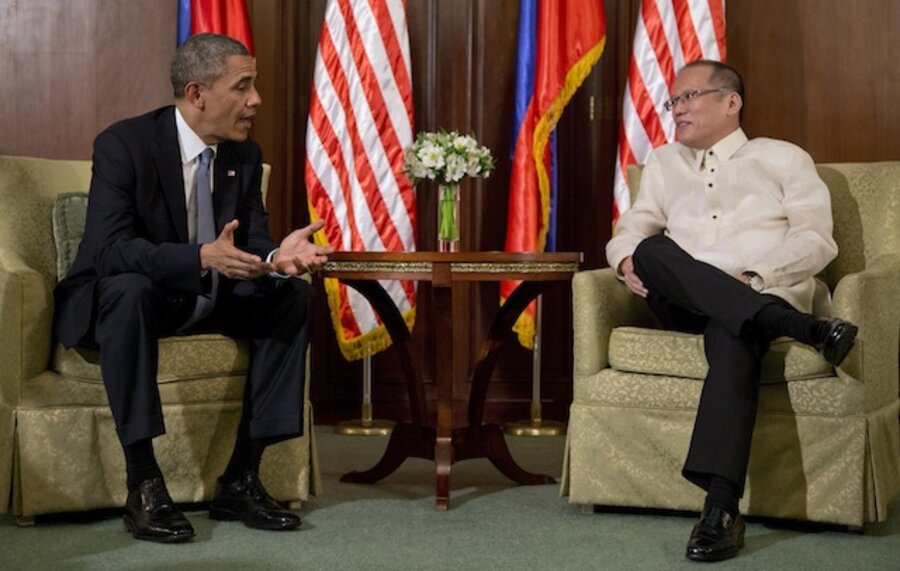US, Philippines boost military ties. Why now?
Loading...
| Manila, Philippines
The US and the Philippines signed a 10-year defense agreement Monday with the potential to significantly increase US military forces in the country.
After two years of talks, US and Philippine negotiators came to terms on an arrangement that supports President Obama's "pivot" of US military strength in Asia at a time when China’s expanding military presence has raised tension throughout the region.
The United States – which long maintained major bases in the Southeast Asian nation – has been barred for more than two decades from any permanent military presence in the country. Under the new agreement the US military will be able to send ships and planes to Clark Air Base and the Subic Bay Naval Base, former US bases now owned by the Philippines, for both commercial and military use.
Mr. Obama, on his first visit to the Philippines, called the agreement an “important new chapter” in the two countries' relationship and sought to counter criticism that it might add tension in the South China Sea, which China claims in its entirety. The pact's purpose, he said, is to promote peace and stability.
“Our goal is not to contain China," he said in a joint news conference here with the Philippines' President Benigno Aquino. “Our goal is to make sure international rules and norms are respected and that includes in the area of international disputes.”
The agreement marks a milestone in the history of US-Philippine military relations, beginning with the Spanish-American War of 1898 that resulted in the Philippines becoming a US colony. The US developed enormous bases before the Japanese took them over in World War II, and returned to them after the defeat of the Japanese and the independence of the Philippines in 1946. The US gave up the bases in 1991, after the Philippines Senate refused to extend the lease.
How many US troops will be in the Philippines at any time is uncertain, but the agreement leaves open the possibility of thousands in case of a crisis. Although the pact does not authorize a permanent presence, US forces will rotate in and out of existing Philippine bases on missions ranging from training of the Philippines' weak armed forces to humanitarian rescues to advising on combating both communist and Islamic revolt. The agreement also sends a message to China not to assert its control over the South China Sea.
But questions are rising about the deal's constitutionality since the Philippines Constitution, adopted in 1987 a year after the the dictatorial regime of Ferdinand Marcos was overthrown, specifically bans foreign bases or forces on Philippine soil. In the past, that ban has been circumvented by limiting US forces to a "visiting forces agreement."
Both Obama and Mr. Aquino were careful not to attribute the agreement directly to concerns about China’s territorial claims. They also did not mention the Philippines’ claims to the Paracel islands, some of which are held by China, or China’s takeover of the Scarborough shoal west of Subic Bay, a rich fishing ground that the Philippine says is within its territorial limits.
Shifting national mood
Some Filipino political figures, commentators, and demonstrators took issue with the agreement, viewing it as a step toward bringing back thousands of US troops. Filipino ‘nationalist” groups rose in mass protest against US bases after the People Power revolution drove Ferdinand Marcos from the presidency in early 1986, leading to Corazon Aquino’s election as president and finally to adoption in 1987 of the “anti-base” Constitution.
An influential senator, Miriam Defensor Santiago, predicted that the agreement would “further antagonize China” by placing the Philippines in “the American column instead of the China column.”
Yet many observers believe that the popular mood has shifted substantially. “People ... don’t mind [a US troop presence],” says Carlos Conde, a veteran journalist now with Amnesty International in Manila. Famous Filipino political figures who once campaigned vigorously against the bases are now retired or inactive.
Activists “no longer block US interest in the Senate and elsewhere,” he says. Although “the usual leftist” are “still doing it,” he adds, “if anything, they’re criticized for creating traffic jams every time they hit the streets.”
Small protests
About 2,000 protesters were doing just that on Monday, challenging rows of policemen at the Mendiola Bridge three blocks from Malacanang Palace where Obama and Aquino were meeting and then holding forth at a press conference. Banners and placards read: “Obama Out” and “Philippines Not for Sale.” Elsewhere, an image of Obama was burnt in effigy.
The protesters, relatively small in numbers, have the support of intellectual figures often critical of the government.
The Philippine Inquirer, a leading newspaper, editorialized, “We have long advocated that any enhancement in defense cooperation between the Philippines and the United States must have the consent of the senate…. Malacanang’s failure to submit the agreement to a largely friendly Senate is inexplicable.”
Others, however, disagree. The agreement “enhances security for the region,” says Jerome Gonzalez, head of research for PhilEquity, an investment firm. Investors would rather not pay attention to territorial disputes with China, preferring to be able to “dismiss tensions.”







